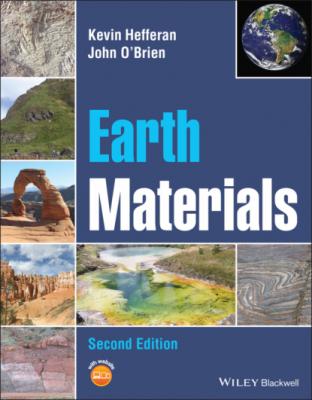Earth Materials. John O'Brien
Читать онлайн.| Название | Earth Materials |
|---|---|
| Автор произведения | John O'Brien |
| Жанр | География |
| Серия | |
| Издательство | География |
| Год выпуска | 0 |
| isbn | 9781119512219 |
14 Chapter 15Table 15.1 Common hydrothermal alteration processes.Table 15.2 Protolith and major minerals of common non‐foliated and foliated ...Table 15.3 Common protoliths and minerals associated with pelitic assemblage...Table 15.4 Common protoliths and minerals associated with quartzofeldspathic...Table 15.5 Common calcareous protoliths, minerals associated and metamorphic...Table 15.6 Common protoliths and minerals associated with mafic and intermed...Table 15.7 Common protoliths and minerals associated with ultramafic assembl...
15 Chapter 16Table B16.1 Incompressibility and rigidity values at 1 atm and 25 °C. Note t...Table B16.2 Poisson's ratio values for Earth materials and processed materia...Table 16.1 Approximate temperatures at which some common minerals change fr...Table 16.2 Relative competency of some common rocks at 1 atm and 25 °C.Table 16.3 Mineral and rock strength under compressive and tensile condition...
16 Chapter 17Table 17.1 The tendency of common metamorphic minerals to develop complete ...Table 17.2 Cataclasite series rock terms developed by Sibson (1977).Table 17.3 Mylonite series as defined by Sibson (1977).
17 Chapter 18Table 18.1 Barrovian zones in pelitic, calcareous, and mafic protoliths.Table 18.2 Mineral assemblages and rocks in albite–epidote hornfels facies r...Table 18.3 Mineral assemblages and rocks in hornblende hornfels related to p...Table 18.4 Mineral assemblages and rocks in pyroxene hornfels related to pro...Table 18.5 Mineral assemblages and rocks in sanidinite hornfels related to c...Table 18.6 Zeolite minerals and chemical formulas.Table 18.7 Common minerals and protoliths of the zeolite facies.Table 18.8 Common minerals and protoliths of the prehnite–pumpellyite facies...Table 18.9 Common minerals and protoliths of the greenschist facies.Table 18.10 Common minerals and protoliths of the amphibolite facies (Turner...Table 18.11 Common minerals and rocks in granulite facies based on protolith...Table 18.12 Common minerals and rocks in blueschist facies based on protolit...Table 18.13 Common minerals and rocks in eclogite facies based on protolith ...
18 Chapter 19Table 19.1 VMS classifications proposed since 1986 based on type locality (C...Table 19.2 Some additional base metal occurrences and uses are presented.Table 19.3 Common rare Earth metal (REE) uses.Table 19.4 Common steel alloys (Kesler 1994; USGS 2020).Table 19.5 Common mineral pigments used for providing color to materials.Table 19.6 Some of the more common gems are described in this table.Table 19.7 Metals commonly provide vibrant color to gemstones.Table 19.8 Key elements, referred to by nutritionists as macro‐ and micro‐mi...Table 19.9 Naturally occurring toxic elements segregated based on whether th...
List of Illustrations
1 Chapter 1Figure 1.1 Standard cross‐section model of the geosphere. Major compositiona...Figure 1.2 Major layers and seismic (p‐wave) velocity changes within Earth; ...Figure 1.3 World map showing the distribution of major plates separated by b...Figure 1.4 Principal types of plate boundaries: (a) divergent; (b) convergen...Figure 1.5 Major features of continental rifts include rift valleys, thinned...Figure 1.6 Model showing the growth of ocean basins by sea floor spreading f...Figure 1.7 Map of the ocean floor showing the distribution of the oceanic ri...Figure 1.8 The formation of oceanic crust along the ridge axis generates lay...Figure 1.9 Model depicts the production of alternating normal (colored) and ...Figure 1.10 World map showing the age of oceanic crust; such maps confirmed ...Figure 1.11 Convergent plate boundary, showing trench‐arc system, inclined s...Figure 1.12 Subduction zone depicting details of sediment distribution, sedi...Figure 1.13 (a) Ocean basin shrinks by subduction, as continents on two plat...Figure 1.14 (a) Diagram depicting the convergence of India and Asia which cl...Figure 1.15 Transform faults offsetting ridge segments on the eastern Pacifi...Figure 1.16 Fracture zones, transform faults and ridge segments in the easte...Figure 1.17 (a) Linear seamount chain formed by plate movement over the Hawa...
2 Chapter 2Figure 2.1 Simplified model atom with nucleus that contains positively charg...Figure 2.2 (a) Nuclear configurations of the three common isotopes of hydrog...Figure 2.3 Distribution of electrons in the principal quantum levels (“elect...Figure 2.4 The quantum properties of electrons in the 92 naturally occurring...Figure 2.5 The diagonal rule for determining the sequence in which electrons...Figure 2.6 Trends in variation of atomic radii (in angstroms; 1 Å = 10−10...Figure 2.7 Radii (in angstroms) of some common cations in relationship to th...Figure 2.8 Radii (in angstroms) of some common anions in relationship to the...Figure 2.9 Radii (in angstrom units) of some common anions and cations of su...Figure 2.10 (a) Ionic bonding develops between highly electronegative anions...Figure 2.11 Relationship between attractive and repulsive forces between ion...Figure 2.12 Covalent bonding in oxygen (O2) by the sharing of two electrons ...Figure 2.13 (a) Covalent bonding (double lines) in a carbon tetrahedron with...Figure 2.14 A model of metallic bonds with delocalized electrons (dark red) ...Figure 2.15 Graph showing the electronegativity difference and bond type in ...Figure 2.16 Triangular diagram representing the bond types of some common mi...Figure 2.17 Van der Waals bonding occurs when one atom becomes dipolar as th...Figure 2.18 Diagram showing two water molecules joined by a hydrogen bond th...Figure 2.19 Common coordination polyhedra: (a) cubic closest packing, (b) cu...Figure 2.20 A silica tetrahedron is formed when four oxygen ions (O−2)...
